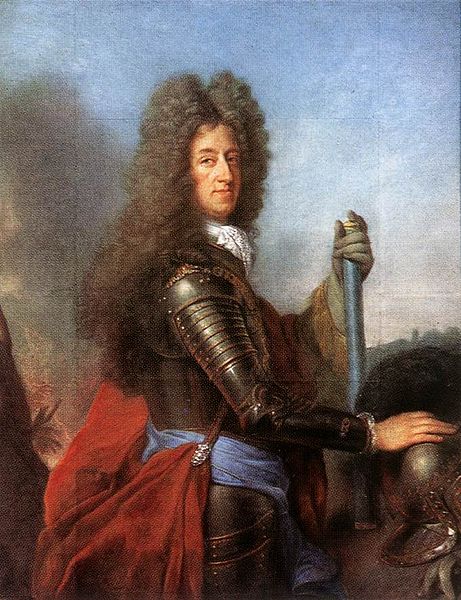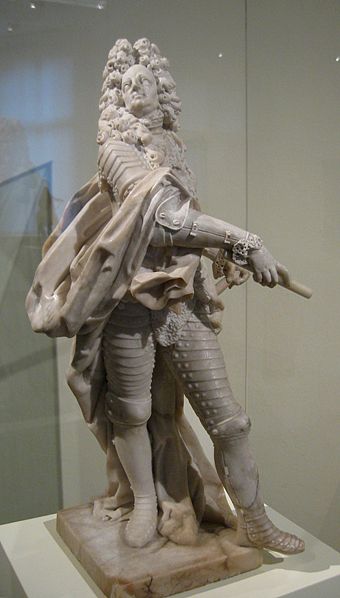<Back to Index>
- Folklorist Alexander Nikolayevich Afanasyev, 1826
- Sculptor Louis - Eugène Simonis, 1810
- Elector of Bavaria Maximilian II Emanuel, 1662
PAGE SPONSOR


Maximilian II (July 11, 1662 - February 26, 1726), also known as Max Emanuel or Maximilian Emanuel, was a Wittelsbach ruler of Bavaria and an elector (Kurfürst) of the Holy Roman Empire. He was also the last Governor of the Spanish Netherlands and duke of Luxembourg. An able soldier, his ambition led to conflicts that limited his ultimate dynastic achievements.
He was born in Munich to Ferdinand Maria, Elector of Bavaria, and Henriette Adelaide of Savoy (d.1676). His maternal grandparents were Victor Amadeus I of Savoy and Christine Marie of France. Christine Marie was the second daughter of Henry IV of France and his second wife Marie de' Medici. Maximilian inherited the elector's mantle while still a minor in 1679 and remained under his uncle Maximilian Philipp Hieronymus's regency until 1680. By 1683 he was already embarked on a military career, fighting in the defense of Vienna against the attempt of the Ottoman Empire to extend their possessions further into Europe. He returned to court for long enough to marry Maria Antonia, daughter of Leopold I, Holy Roman Emperor and Margaret Theresa of Spain, on 15 July 1685 in Vienna, Austria.
This marriage was very unhappy since the couple disliked each other,
but it was successful in producing a desired heir for both Bavaria and
the Spanish monarchy. Maximilian Emanuel's fame was assured when, in 1688, he led the capture of Belgrade from the Turks, with the full support of Serbian insurgents under the command of Jovan Monasterlija. In the War of the Grand Alliance he again fought on the Habsburgs' side, protected the Rhine frontier, and, being the Emperor's son - in - law
and the husband of the King of Spain's niece, was appointed governor of the Spanish Netherlands in late 1691. His
Netherlands adventure catalyzed Maximilian Emanuel's dynastic
ambitions. One year after his appointment as governor, Maria Antonia
died in Vienna, after having given birth to a son, Joseph Ferdinand,
who became the rightful heir to the Spanish monarchy until his death.
An alternative avenue for Maximilian Emanuel's ambition was offered by
his 12 January 1694, marriage to Theresa Kunegunda Sobieska, the death of whose father, the elected King of Poland Jan III Sobieski, two years later, offered a potential avenue of influence in Polish affairs. However, he concentrated his interests in Western Europe and making his sons by Theresa Kunegunda Sobieska, Charles Albert and Klemens August, the principal outlets for his ambitions. The unsuccessful siege and bombardment of Brussels in 1695 during the Nine Years' War by
French troops and the resulting fire during Max Emanuel's rule were
together the most destructive event in the entire history of Brussels. In 1699 Maximilian Emanuel's first son Joseph Ferdinand, appointed heir of the Spanish crown, died. By the outbreak of the War of the Spanish Succession in 1701, he had developed a plan for the Wittelsbachs to supplant the Habsburgs as Holy Roman Emperors. Allying himself with the French against the Habsburgs, his campaign against Tyrol in 1703 did not have success and his plans were then frustrated by the disastrous defeat at the Battle of Blenheim in
1704. In the ensuing evacuation of his court to the Netherlands,
Maximilian Emanuel's family became separated and his sons were held prisoners for several years in Austria, Klemens August being brought up by Jesuits. Bavaria was partitioned between Austria and the elector palatine, the Wittelsbach John William, leading to bloody uprisings of the people against the Austrian imperial troops. Maximilian Emanuel was again forced to flee the Netherlands after the Battle of Ramillies (23 May 1706) and found refuge at the French court in Versailles where his late sister Maria Anna Victoria (1660 – 1690) had been the wife of Le Grand Dauphin. In 1712 Luxembourg and Namur were ceded to Maximilian Emaunel by his French allies. The war was finally ended in 1713 in the Treaty of Utrecht which restored Maximilian Emanuel. Only in 1715 was the family re-united in Munich. Back
in Bavaria, Maximilian Emanuel put much energy on his building projects
to balance the failure of his political ambitions. It was bitter for
him to witness the royal elevation of the German princes Augustus II the Strong (1697), Frederick I of Prussia (1701) and George I of Hanover (1714) while his own political dreams could not be realized. Maximilian Emanuel then supported the new wars of the Habsburg against the Turks with Bavarian auxiliary forces (1717). In 1724 he created a union of all lines of the Wittelsbach dynasty
to increase the influence of his House. The Wittelsbach prince -
electors Max Emanuel, his son Clemens August of Cologne, Charles III Philip, Elector Palatine and Franz Ludwig of Trier had
at that time four votes at their disposal for the next imperial
election. The crown of the Holy Roman Empire was aspired either for Max
Emanuel or his son Charles Albert. Already in 1722 Charles Albert had
been married to the Habsburg princess Maria Amalia of Austria. Maximilian Emanuel founded in 1726 the Royal Order of Saint George for the Defense of the Immaculate Conception, a dynastic Order of the Royal House of Bavaria. Maximilian Emanuel is buried in the crypt of the Theatinerkirche in Munich. During his entire reign Maximilian II Emanuel patronized the arts. As Governor of the Spanish Netherlands he acquired numerous Dutch and Flemish paintings for the Wittelsbach collection. The first half of Max Emanuel's reign was still dominated by his parent's Italian court artists, like Enrico Zuccalli and Giovanni Antonio Viscardi. With the appointment of Joseph Effner serving as chief architect of the court and the young François de Cuvilliés as
his assistant, the French influence significantly increased and Max
Emanuel's return in 1715 marked the origin of the era of Bavarian rococo. The Nymphenburg Palace was enlarged, the Dachau Palace redesigned and the new Schleissheim Palace was
constructed during his reign. These palaces were connected with a
network of canals as Max Emanuel became acquainted with in the
Netherlands. The Fürstenried Palace was built for Max Emanuel as a hunting lodge.